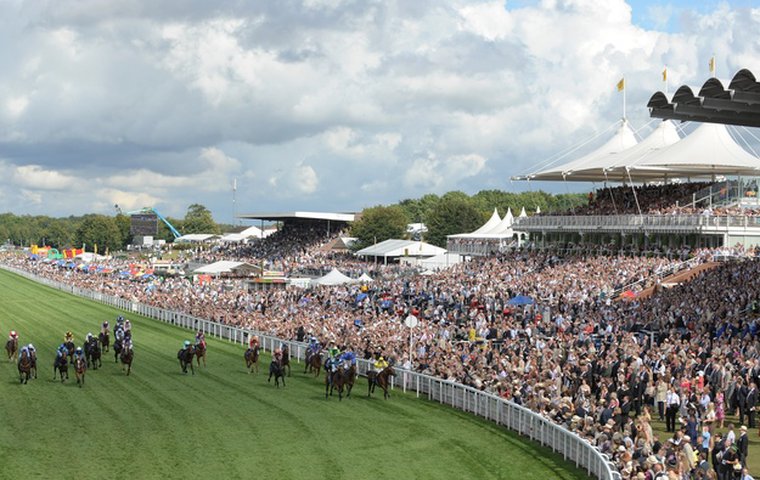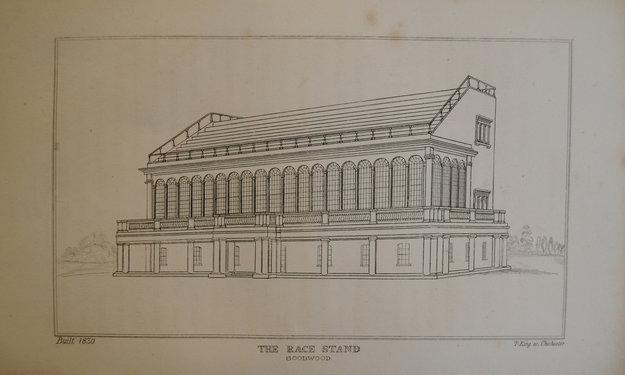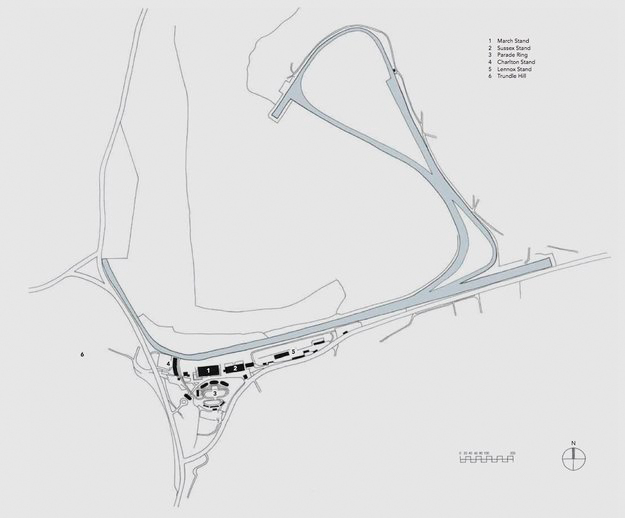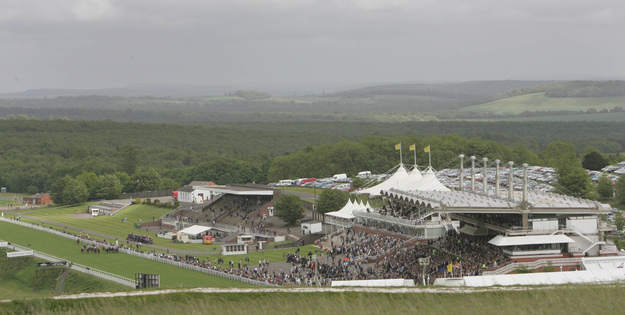
Now regarded as one of the world’s most attractive racecourses, Goodwood was born by chance. The third Earl of Egremont had, for some years, hosted an annual race meeting for the local Militia on his country estate, Petworth Park, but in 1801, he unexpectedly cancelled the event. However, the third Duke of Richmond stepped in to save the day and invited the regiment to hold their races at his nearby Goodwood estate. The event won such plaudits that a second meeting was planned for the following year, this time open to the public. Glorious Goodwood 2014 opens Tuesday, July 29.
Barring a small timber stand constructed in 1802, Goodwood Racecourse possessed no permanent buildings until the 1830s. This changed with the accession of the fifth Duke of Richmond. In partnership with Lord George Bentinck, senior steward of The Jockey Club and a passionate reformer of the turf, the duke marshalled a series of improvements: the course was re-laid, gallops were set out (complete with the Victorian equivalent of an all-weather surface), the finishing straight extended, and a large grandstand was erected. These alterations elevated Goodwood from an interesting but essentially local meeting to one of Britain’s leading courses, in the league of Ascot, Epsom, and Newmarket.
Goodwood’s new grandstand was typical of contemporary British racecourse architecture. Built in 1830 to replace the 1802 stand, it expanded the template of 18th-century grandstands and added innovations in seating provision. Measuring 36-by-21 metres, it housed refreshment rooms on its ground floor, a glazed saloon with adjacent betting rooms above, and a large, steeply raked and benched rooftop terrace, named the Betting Stand. In 1837, a balcony was extended from the first-floor saloon, which added 400 places to an already generous capacity of nearly 3,000. “At once tasteful and convenient, elegant and commodious,” contemporaries enthused about the improvement that the new, neo-classical grandstand made to the course.

A weighing room, in classical style, followed in 1841, whilst the sum of refreshment booths, “Punch and Judy” tents, coconut stalls, and others grew into a sea of pitched canopies around the racecourse’s edge. Attendances thrived.
However, after the spate of activity in the 1830s, no new buildings were erected for more than 60 years. By the turn of the 20th century, Goodwood’s former gloss had faded. Fortunately, the seventh Duke of Richmond, who acceded to the title in 1903, determined to reverse this ebb.
The seventh duke was perhaps an unlikely white knight. A dour, punctilious, military figure, he nevertheless had a passion for racing. This trait came to bear in the commissioning of a new grandstand to replace the outdated 1830 stand. Erected in 1903-4, it was four times the length of the old stand. With a palette of red brick and decorative cast iron, the new building epitomised the Edwardian grandstand in Britain. At the same time, a stand for the press, known as the Charlton Building, was erected immediately to its west.
A resounding success, the new stands were born of a spirit of renewal at Goodwood initiated by Edward VII (1901-1910), Britain’s playboy monarch. Edward patronised the “sport of kings” with relish, and this included the Goodwood races. Amidst an exuberant eddy of high-spirited house parties, royal guests, and unstinting entertainment, Goodwood arrived at its social apotheosis. Christened “Glorious Goodwood,” its July meeting became the apogee of the summer season. It was “really a garden party with racing tacked on,” Edward VII summarised.
The king’s patronage boosted Goodwood’s prestige and popularity, but it was not until long after his reign that further construction took place. The Lennox Stand, built between 1935 and 1938, was the course’s first public stand. It was a very different affair to its predecessors. A spare and utilitarian redbrick structure built in stripped Art Deco style, it is the earliest of Goodwood’s buildings that survives today. Indicative of its purpose as lower-priced accommodation for the general public, it commanded a poor view over the track. More fortunate were those patrons privileged enough to enjoy the new members-only Private Stand (later called the Richmond Stand). Opened in 1938 and capable of holding 2,400, it overlooked the head of the track from its front and the paddock from the rear. Like Goodwood’s other stands, it too was a red brick structure.
With the advent of the motorcar, travelling to Goodwood was easier than ever before. Crowds swelled. By the 1950s, its summer festival drew a daily average of 50,000. Over a third of this total, however, found accommodation not within Goodwood’s four stands, but on “the most glorious free grandstand in the history of racing” – Trundle Hill. On the Trundle, racegoers enjoyed ideal views over the track and parade ring. Here, travelling vendors jostled against strolling players and acrobats, amid a medley of refreshment booths, tented pavilions, shooting galleries, and skittle alleys. Its holiday spirit characterised the course.

However, the Trundle’s vista was checked in 1976 when Goodwood’s parade ring was moved to the rear of the grandstand. This presaged the recent trend amongst racecourses to relocate their parade rings to more “spectator friendly” locations, displayed at Ascot (2006), Chantilly (2007), and Ayr (2008). At Goodwood, the relocation of the parade ring marked the beginning of a redevelopment programme. Within this programme, no building made greater impact than the March Stand, opened by the Queen in 1980.
The three-story March Stand supplanted the 1904 grandstand, the Charlton Building and the Richmond Stand. Although it incorporated cast-iron balustrades salvaged from the 1904 grandstand and used red brick for its base, the new stand was resolutely modern. It is remarkable for its precast concrete roof, a vast cantilevered canopy made from 10 lightweight elliptical vaults suspended over stepped terraces.
Like many post-war grandstands, the March Stand privileged corporate entertainment over the everyday racegoer. The unenclosed bottom level was assigned to the public, while 30 private boxes were provided above. Eighteen of these overlooked not the course but the paddock – a controversial first in British racecourse design. Goodwood was now “in the entertainment industry,” the current Duke of Richmond announced in 1970.
Perhaps unsurprisingly, Goodwood was criticised by both the racing press and its membership for its neglect of the paying public. As a result, in 1987, Goodwood commissioned a new masterplan. Over the next 15 years, the racecourse underwent an architectural transformation that yielded one of the most distinctive and well-designed environments of any sporting ground.
The reformation commenced with the opening of the Sussex Stand in 1990. Offering a breath of fresh air for the racing world, and an inversion of racing’s traditional hierarchies, the public enjoyed the best views from the top tier of the three-level stand, whilst the “privileged” hospitality suites were relegated to the tier below.
No less refreshing was the stand’s appearance. Built upon a red-brick-faced base and featuring rear-facing balconies overlooking the parade ring, the stand harmonised with Goodwood’s traditional brick palette. However, its design was far from customary. Inspired by the ocean of temporary tents and marquees that covered the racecourse each summer, the stand was crowned by a brilliant-white, fabric roof, seemingly floating above the lower tiers. Almost instantaneously its tented roof became an emblem of the relaxed, summertime ambiance of the Goodwood meeting, a permanent manifestation of the “garden party” atmosphere savoured by Edward VII. So successful was the Sussex Stand, in fact, that when Goodwood came to remodel the course at the turn of the 21st century, it formed the starting point of the new scheme. Facing increased competition, concerns had mounted at Goodwood that the course lagged behind other major racecourses, particularly in terms of hospitality. In 1997, Hopkins Architects was engaged to determine how Goodwood could be improved.
The results were a celebrated success. Hopkins upgraded three of the racecourse’s key spaces – the winners’ enclosure, parade ring, and weighing-in building – and added three light-weight, light-hearted hospitality pavilions. They were essentially summer structures, in effect updated versions of the village green marquee or the white-pitched tents that are indelibly associated with summer sports in Britain. The principle of the design was to include as little structure as possible, not only to ensure unimpeded views over the parade ring but also to augment Goodwood’s “garden party” ethos. Their festal, open aesthetic represented a turning point for Goodwood, and for racecourse architecture in the U.K. as a whole.

Today, Glorious Goodwood is fêted as a key fixture in European horseracing. Without its series of forward-facing architectural interventions – both respectful of history and modern in outlook – it is unlikely that the racecourse, so transient in its foundation, would retain such a permanent, and unique, presence amongst the British horseracing elite.


